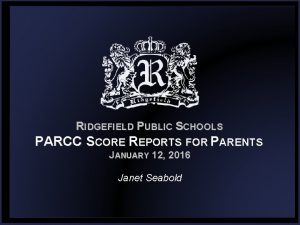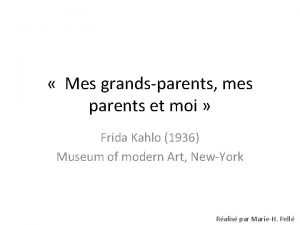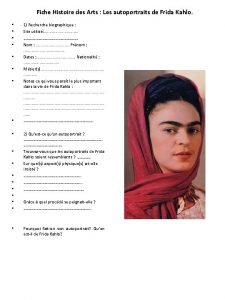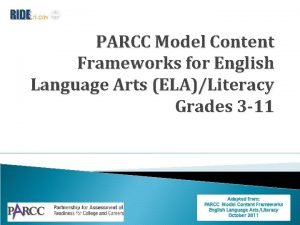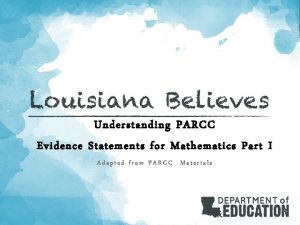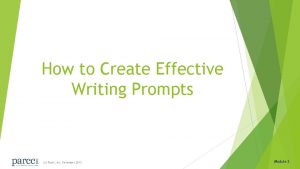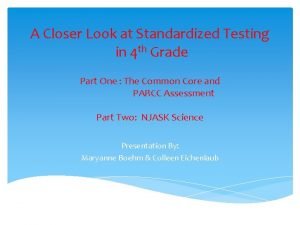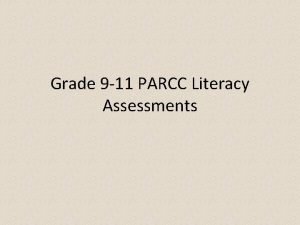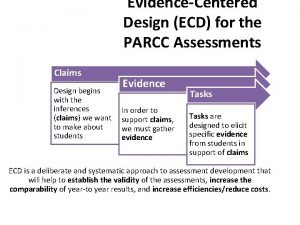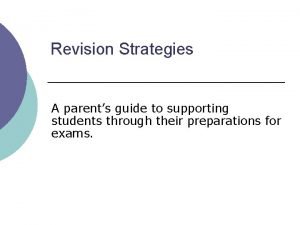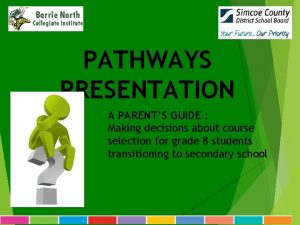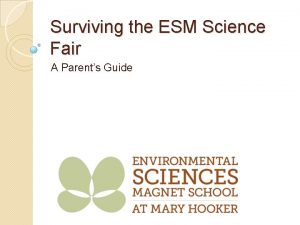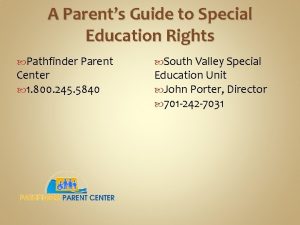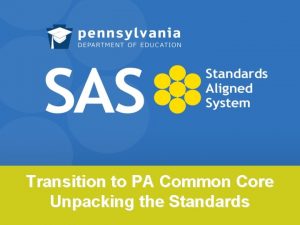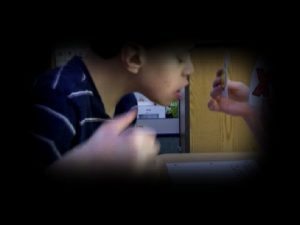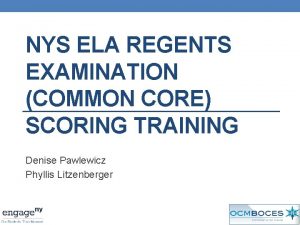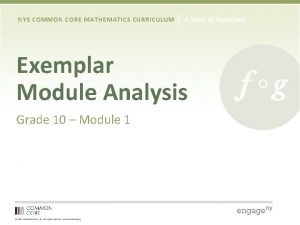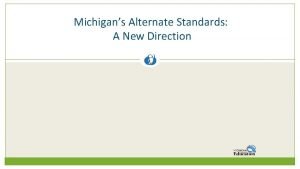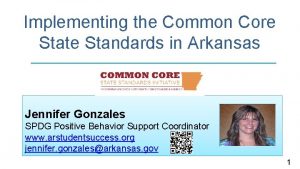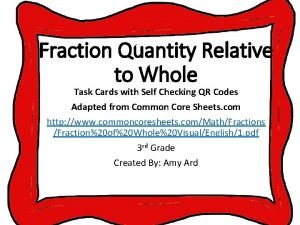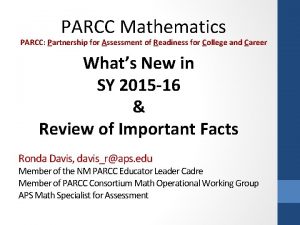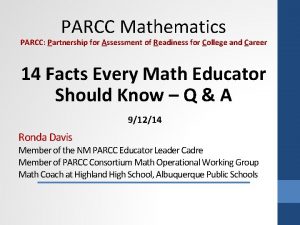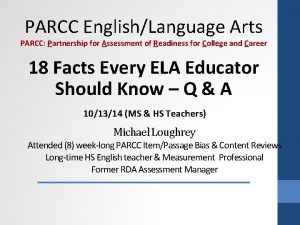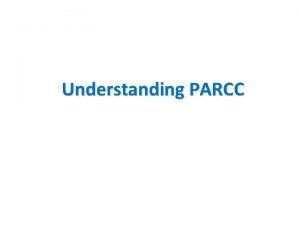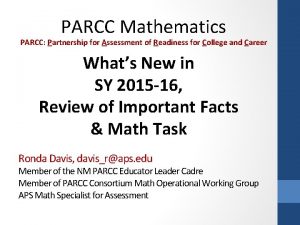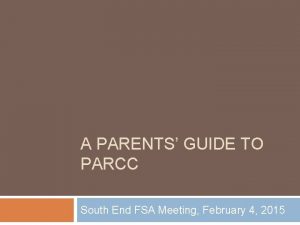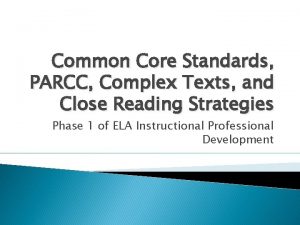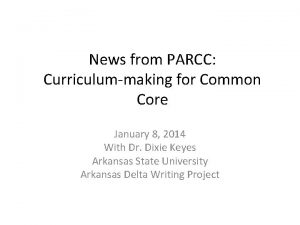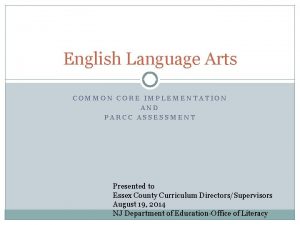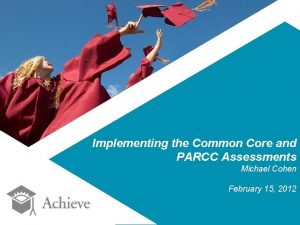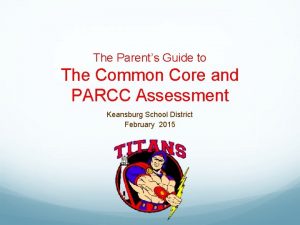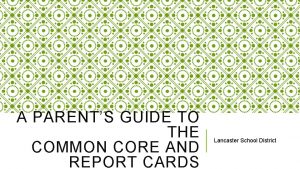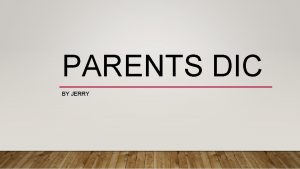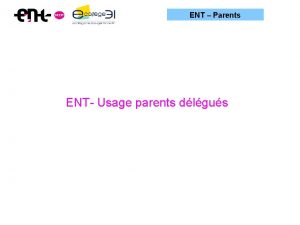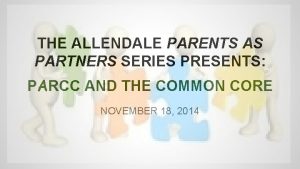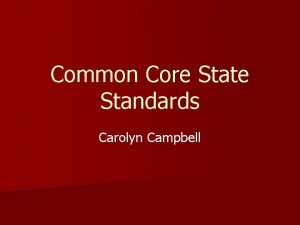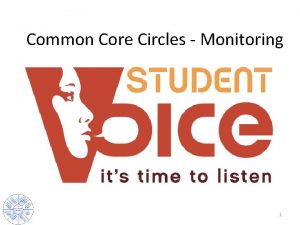COMMON CORE PARCC A PARENTS GUIDE Common Core


























- Slides: 26

COMMON CORE & PARCC: A PARENT’S GUIDE

Common Core 2

What are Educational Standards? 3 What students should know and be able to do at each grade level.

How are Content Standards typically created? 4 State Department of Education State committees

New Jersey Core Curriculum Content Standards (NJCCS) 5 Visual and Performing Arts Health and Physical Education Language Art Literacy Mathematics Science Social Studies World Language Technology Career Education and Consumer, Family and Life Skills

What is Common Core? • • Standards for Language Arts & Math Describe the knowledge and skills that a student needs by the end of each school year and when they graduate from high school. How are they different from past standards? • • Created at the national level Voluntarily adopted by 43 states(*New Jersey adopted the standards in 2010)

Remember: Standards are the “What” Standards are the overall goal we hope our children achieve. Curriculum is the “How” Curriculum is the individual teaching methodology used in the classroom.

Why were the Common Core created? Disparate standards across states Student mobility Global competition Today’s jobs require different skills

How does Common Core address concerns? Fewer, clearer, and higher Aligned with college and work expectations Include rigorous content and application of knowledge through high-order skills Build upon strengths and lessons of current state standards Internationally benchmarked, so that all students are prepared to succeed in our global economy and society Ensures consistent expectations regardless of a student’s zip code

Common Core Standards for English Language Arts (ELA) 10 LET’S TAKE A CLOSER LOOK…

Key Shifts for ELA • • Increased complexity of texts- CLOSE READING A return to depth as opposed to breadth Increased focus on justifying and presenting results and methods– DEVELOPING CLAIMS WITH EVIDENCE Critical reading and writing infused in all curricular areas-INTERDISCIPLINARY

The Three Sections of ELA 12 K-5 (cross disciplinary) 6 -12 English Language Arts 6 -12 Literacy in History/Social Studies, Science, & Technical Subjects

Four Strands 13 Reading Writing Speaking & Language Listening • Comprehension • Knowledge of • Foundations • Opinion & Collaboration • Literature • Informative language • Presentations • Vocabulary • Informational • Narrative of knowledge & ideas

College and Career Readiness Anchor Standards 14 Each of the four strands are grounded by what are known as the “Anchor” Standards. These are known as the “College & Career Readiness Anchor Standards” Broad expectations across grade levels (they spiral throughout all the grade levels. ) Based on evidence about college and workforce training expectations. (i. e. , where students should end up at by the time they graduate high school)

Moving from General to Specific 15 College & Career Readiness Anchor Standards Grade-Specific Standards

Reading Example: 16 Reading Anchor Standard #3: Analyze how and why individuals, events, and ideas develop and interact over the course of a text. Kindergarten Grade One Grade Two Grade Three Grade Four With prompting and support, identify characters, settings, and major events in a story. Describe characters, settings, and major events in a story, using key details. Describe how characters in a story respond to major events and challenges. Describe characters in a story (e. g. , their traits, motivations, or feelings) and explain how their actions contribute to the sequence of events. Describe in depth a character, setting, or event in a story or drama, drawing on specific details in the text (e. g. , a character’s thoughts, words, or actions).

Common Core Overview 17

PARCC 18 PARTNERSHIP FOR ASSESSMENT OF READINESS FOR COLLEGE AND CAREERS

What is PARCC? 19 Assess the Common Core Standards Starting in Grade Three (through Grade 11) Represents 12 states (Arkansas, Colorado, District of Columbia, Illinois, Maryland, Massachusetts, Mississippi, New Jersey, New Mexico, New York, Ohio, and Rhode Island. ) Replace existing state assessments (e. g. , NJASK) starting in March 2015

Technology PARCC will also use technology throughout the design and implementation of the assessment system. Assessments will be administered via computer, and a combination of automated scoring and human scoring will be employed.

Components of the PARCC assessment 21 ENGLISH LANGUAGE ARTS

Performance Based Assessment (PBA) 22 When: March 2015 Design: 3 separate tasks Literary analysis task Research simulation task (RST) Narrative task For each task, students will be asked to: Read one or more texts (Grade 4: RST may include video) Answer several short comprehension and vocabulary questions (on average, 3 to 5 questions per reading) Write an essay that requires them to draw evidence from the text(s). Length of each task: between 60 and 90 minutes Number of testing sessions: Three (one per task)

End of Year Assessment (EOY) 23 When: May 2015 Design: One Task 1 short literary passage with 5 questions 1 long informational passage with 8 questions No essay Total: 2 reading passage sets, 13 items Length of Time: 75 minutes Number of sessions: One

Preparing for PARCC 24

How can you help your child prepare for PARCC? 25 Ask your child specific questions about what they read. Encourage children to read, then write and speak about, nonfiction text such as newspapers, magazines, and biographies. Encourage children to research topics of interest and read series that relate to a central topic. Practice computer skills by reading online and typing. PARCC Sample Test: http: //practice. parcc. testnav. com/

Online Support NJ DEPT. OF EDUCATION: WWW. STATE. NJ. US/EDUCATION/SCA COMMON CORE PARENT PAGE: WWW. COMMONCORE. COM/PAGE/PARENTRESOURCES PARCC PARENT PAGE: WWW. PARCCONLINE. ORG/FOR-PARENTS
 Parcc scoring guide
Parcc scoring guide Frida kahlo grands parents
Frida kahlo grands parents Parents parents
Parents parents Frida kahlo mes grands parents mes parents et moi analyse
Frida kahlo mes grands parents mes parents et moi analyse Parcc model content frameworks
Parcc model content frameworks Parcc evidence statements
Parcc evidence statements Parcc writing prompts
Parcc writing prompts What does parcc stand for
What does parcc stand for Parcc
Parcc Parcc evidence statements
Parcc evidence statements Qehs moodle
Qehs moodle Elysium parents guide
Elysium parents guide All things fair parents guide
All things fair parents guide Pathfinder parents guide
Pathfinder parents guide Downton abbey parents guide
Downton abbey parents guide Parents gateway user guide
Parents gateway user guide Inner core and outer core
Inner core and outer core Characteristics of continental crust
Characteristics of continental crust Crust outer core inner core mantle
Crust outer core inner core mantle Core rigidity
Core rigidity Pa common core standards
Pa common core standards Common core essential elements
Common core essential elements Regents part 3 rubric
Regents part 3 rubric Nys common core mathematics
Nys common core mathematics Common core essential elements michigan
Common core essential elements michigan Common core state standards arkansas
Common core state standards arkansas Fraction quantity relative to whole
Fraction quantity relative to whole
